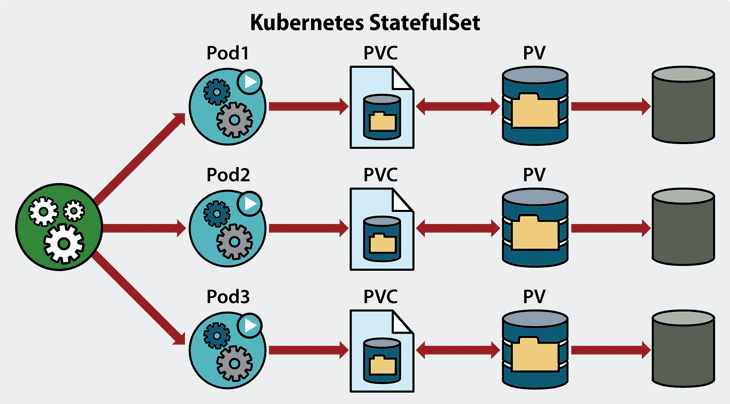Kubernetes Storage enables persistent, stateful data retention within cluster deployments. Explore how Kubernetes Works. Click here now.


Kubernetes is a container orchestration platform that provides the services and management features necessary to deploy, operate, and scale containers across a cluster or in a cloud computing environment. It has become a standard container orchestration method for organizations across a wide range of industries. This is especially true for organizations seeking to scale containerized applications.
It offers a flexible way to automate, deploy, and manage container workloads. Kubernetes storage is useful to storage administrators because it enables different forms of persistent, stateful data retention within Kubernetes cluster deployments, which are growing increasingly popular.
This article provides an overview of Kubernetes and persistent storage, how it works, and the benefits of using it.
To be clear, while Kubernetes storage is sometimes used in the cloud, it is a separate and distinct entity from cloud storage. Google created the Kubernetes platform in 2014 as an open-source effort to help manage the company’s container deployment. The platform moved to the Linux Foundation’s Cloud Native Computing Foundation (CNCF) in 2016 and is now a multi-stakeholder project supported by all major public cloud providers, including Amazon Web Services (AWS), Oracle, Microsoft Azure, and Google Cloud Platform.
Kubernetes has become an important technology in recent years because of its portability. The same basic Kubernetes container that runs in one public cloud can be run in another with little or no change. The portability also enables multicloud deployments, where Kubernetes is used to orchestrate container deployments in more than one cloud platform.
Cloud native is another term often directly associated with Kubernetes, thanks in part to the fact Kubernetes is the foundational project of the Cloud Native Computing Foundation. In this case, cloud native refers to applications—storage or otherwise—built specifically for the cloud rather than being built for the data center and later ported to the cloud.
Application containers offer a way of packaging and delivering applications in a portable format. The most commonly used application container type with Kubernetes is a Docker container. With Kubernetes, multiple sets of containers can be deployed, scaled, and replicated for high availability and application stability.
Learn more: Kubernetes Review
Kubernetes can be described as using a “master-worker” structure within a cluster of nodes. The master node acts as a control center, providing oversight of the cluster’s operation and overall state of the system. Operations include actions like scheduling, scaling, and generally orchestrating workloads across subordinate “worker” nodes that host the actual containers running applications. Master nodes typically communicate with worker nodes via API servers.
The Kubernetes architecture is designed with replication and availability as top priorities. There are several key elements included in any Kubernetes architecture:

Kubernetes allows developers to deploy and scale containers across a cluster or in a cloud computing environment.
When Kubernetes was first developed, it was primarily used for stateless applications that did not have persistent storage requirements. Modern Kubernetes, however, is a different story and is fully capable of managing stateful applications and persistent storage.
There are several key concepts that are important to understand when it comes to Kubernetes storage. First, there is the container storage interface (CSI), which is the connection point for storage systems. Additionally, there are the storage enablement capabilities within pods, such as persistent storage objects, which can be used to request and connect to storage.
The CSI is a relatively recent addition to Kubernetes, but it is one that greatly simplifies storage management and connectivity.
Prior to CSI, storage device drivers had to be directly integrated with the core Kubernetes code, which was a more time-consuming process for enabling new storage devices.The CSI provides an extensible plugin architecture that offers multiple benefits.
Key elements of the Container Storage Interface include the following:
While the CSI provides a way to connect storage devices to a Kubernetes cluster, support is still needed for Kubernetes applications to get access to storage. To that end, there are several key concepts for defining persistent storage objects:
Kubernetes offers several key benefits to organizations seeking to upgrade their containerized application management process:
Kubernetes is a rapidly developing technology that has been embraced by cloud vendors and enterprises alike to enable a more agile and scalable form of application delivery. With a properly implemented Kubernetes storage configuration, databases and application data can be created and accessed by many applications, enabling greater speed and efficiency.
Read next: Top 8 Kubernetes Alternatives


Sarah Bricker Hunt covers wide-ranging topics for various audiences, including tech-focused features on data privacy, telecom, corporate and consumer technology trends, and more. Hunt's work is frequently featured in print publications, B2B and B2C trade journals, and numerous high-profile websites.

Enterprise Storage Forum offers practical information on data storage and protection from several different perspectives: hardware, software, on-premises services and cloud services. It also includes storage security and deep looks into various storage technologies, including object storage and modern parallel file systems. ESF is an ideal website for enterprise storage admins, CTOs and storage architects to reference in order to stay informed about the latest products, services and trends in the storage industry.
Property of TechnologyAdvice. © 2025 TechnologyAdvice. All Rights Reserved
Advertiser Disclosure: Some of the products that appear on this site are from companies from which TechnologyAdvice receives compensation. This compensation may impact how and where products appear on this site including, for example, the order in which they appear. TechnologyAdvice does not include all companies or all types of products available in the marketplace.